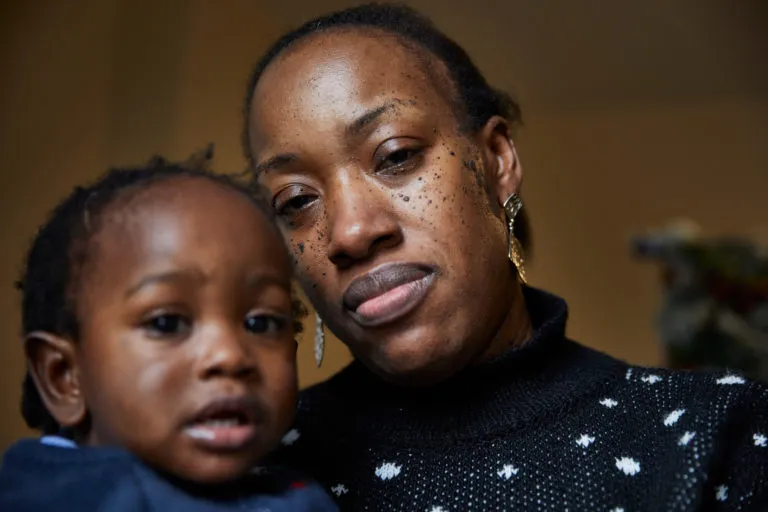The human cost of temporary accommodation
Published: by Sam Stroud

As we recently reported, temporary accommodation cost councils £1.45bn in 202/21. This figure has more than doubled in the last ten years. But while the financial cost of temporary accommodation is enormous, it is the human cost that is truly devasting.
‘It’s like a dumping ground’: a traumatising experience
As part of an upcoming research project, we recently conducted over 30 interviews with people who have experience living in temporary accommodation or who work with people in temporary accommodation.
People spoke of appallingly bad and unsafe conditions in temporary accommodation, ranging from black mould and cockroach infestations to collapsing ceilings. They told us about not being able to access essentials like WiFi and laundry facilities, dangerous overcrowding, and punishing rules set by landlords. These include family members not being allowed to visit.
Sometimes you think why I am living here? What have I done to deserve this? It’s very painful.
Anonymous temporary accommodation resident
People reported being placed in temporary accommodation miles away from their families and communities. Or being given only a few hours’ notice to relocate to an entirely different town which they hadn’t even heard of before.
And others told us how temporary accommodation is often far from temporary. Some had lived in temporary accommodation for years on end and shared their struggles to move on into a settled home because of the lack of social housing and facing discrimination at the hands of landlords and letting agents.
Temporary feels very permanent.
Anonymous temporary accommodation resident
‘It’s draining, very draining’: the harmful impact
We also heard about the tremendous damage temporary accommodation caused to residents’ mental and physical health. They spoke of its devastating effect on their wellbeing; the feelings of powerlessness, fear, isolation and insecurity they struggled with on a daily basis. This was often compounded by hostile communication and broken promises from public authorities and others.
My depression deteriorated. But I was too scared to tell anyone – I needed to live here, because I needed a roof over my head.
Anonymous temporary accommodation resident
Temporary accommodation had a big impact on some people’s finances, too. Various costs included taking hours-long commutes on public transport and having to fork out for repairs that the landlord refused to carry out. Some people struggled to continue working or studying due to the insecurity of not knowing where they would be living from one day to the next.
I hardly sleep at night because I lay in bed worrying.
Anonymous temporary accommodation resident
And we heard about the heartbreaking impact that life in temporary accommodation had on their children. On their physical and mental health, their ability to do homework and concentrate at school, and their social life. Parents talked about children who had been bullied for being homeless or blamed themselves for their situation. One mum said her children promised to be good if they could be moved out of temporary accommodation and into a settled home.
My children will always remember this trauma. This is not an environment where my children should live.
Anonymous temporary accommodation resident
The coronavirus (COVID-19) pandemic and its accompanying restrictions only made the situation worse. It meant families in temporary accommodation were confined to their cramped and dangerous accommodation for months on end.
How our new research project can help
This stark reality underlines the importance of the temporary accommodation research project we recently launched, with funding from Trust for London and the Joseph Rowntree Foundation.
The project will take place over the coming year and will include the first national-level survey of people in temporary accommodation since our 2004 Living in Limbo report. It’s a fitting if disheartening anniversary. The number of households living in temporary accommodation is approaching similar levels to those last seen in the mid-2000s.
Alongside the survey, a central part of the project will be a steering group of people with lived experience of temporary accommodation and grassroots groups working with people in temporary accommodation. The steering group ensures that the people who know temporary accommodation best of all – those who live in it – will shape the project throughout.
As steering group member Shandor Nikitits says: ‘Having been in temporary accommodation myself, it is daunting showing “the world” my vulnerability. If my contribution to this project helps one person feel less daunted and vulnerable then to me, that’s worth it.’
Making the case for new social housing
While these initial findings are shocking enough, the national survey will help us build a comprehensive look at the experiences of people living in temporary accommodation and the devastating impact this has on hundreds of thousands of lives.
By demonstrating the extent of the problem, we hope to convince the government to take action. Only by properly investing in a new generation of good quality and genuinely affordable social housing – so that everyone who needs it has a safe place to call home – will we be able to bring the travesty of temporary accommodation to an end. Help us convince the government to do so by joining our campaign.
You can find out more about our research by getting in touch with Hannah_Rich@Shelter.org.uk or Sam_Stroud@shelter.org.uk.